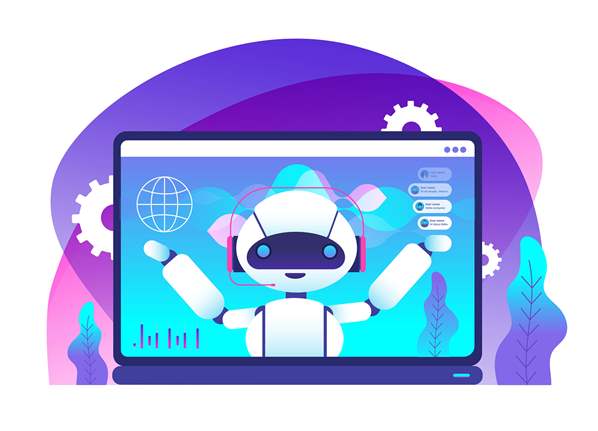
Sarah Al-Hussaini, Co-Founder and COO of Ultimate.ai, explains why chatbots must be part of the customer journey if their full potential is to be realized.
When it comes to chatbots, there are generally two types of sentiment in the market amongst customer service leaders.
The first is that customer service leaders feel pressured by their C-level teams to acquire this burgeoning technology, which they assume is a kind of “off-the-shelf” “plug-and-play” solution. (It’s not.)
On the other side, there are leaders who are protective over the customer experience they work hard to deliver and reject the idea of adding an “impersonal and cold” chatbot. (Which it needn’t be.)
But both of these sentiments falter by oversimplifying exactly what a chatbot is — and the fact that it isn’t a stand-alone solution.
When evaluating new technologies to adopt, you need to be thinking in the context of your customer journey.
Disruptive brands are already reaping the rewards of creating more intelligent customer journeys. Look at Spotify and Netflix, which have used AI to revolutionize the way we discover music and film. Or Amazon, which has done the same with shopping through its recommendation engine.
Each of these services are so seamless that the customer doesn’t even feel the powerful technologies behind them — which is a key component to any great CX tool — and have transformed the customer experience landscape.
For many businesses, a chatbot can be a way to add the same intelligence to their customer service offering. Chatbots can help drive retention and customer advocacy by improving the post-purchase experience you deliver.
But if not implemented in line with your customer journey, a chatbot risks having the reverse effect.
What is a chatbot, and why do you need one?
A chatbot is like a super customer service agent: it works 24/7 without rest, providing consistently positive customer experiences day in and day out. It can take all your repetitive cases off your plate…forever.
But how does it work?
Think of a chatbot as an intelligence layer that is embedded into your customer service. This layer allows you to provide your customers with a self-service solution to solve their simplest cases easily and consistently.
You’ll be very familiar with such cases already: password resets, account unlocks, plan renewals, order status, ticket rescheduling, and even simple FAQ answers like reciting a return policy. All of these are great examples of cases a chatbot can empower your customers to resolve without your team’s help.
Not only does this make your human agents’ jobs less stressful and more fulfilling, but your customers actually prefer helping themselves — Millennials and Gen Zers in particular. According to the Customer Experience Index, three out of four Millennial consumers prefer solving their customer service issues on their own.
Training a chatbot to hold the ground at the frontline of your customer service also puts you less at risk for spikes and seasonality. During times of high consumer traffic – like what the coronavirus outbreak is doing to today’s travel industry – your chatbot will work overtime (and won’t complain about it!) to handle all the repetitive inquiries, and cases that require escalation to a human agent will be far more manageable.
As you can see, businesses stand to gain and win across the board with a chatbot. The customer experience is better, making them more likely to buy and/or return. The demand on your team decreases, freeing up your human agents to tackle the higher-value interactions. And finally, your agent turnover is likely to decrease as their work becomes more rewarding.
But a chatbot is not a silver bullet. These helpful little bots can only do all the things described above if it is seamlessly embedded into your customer journey. To illustrate the role the customer journey has to play, consider the following example.
Imagine a customer that wants to update their bank that they’ll be going on holiday to Mexico for a few weeks. So, they log into their app and start a conversation. It goes something like this:
Hello, I’m Eve the ABC Bank chatbot. How can I help you today?
Hi there, I wanted to let you know that I will be travelling with my card next week.
I’m happy to update your account with your travel plans. Can you let me know which country you will be visiting?
I’m going to Mexico.
Great! And how long will you be travelling for?
For 3 weeks.
Thank you. I have now updated your account. Is there anything else I can help you with today?
No thanks, bye!
[Eve the chatbot marks the case as resolved and tags it as a travel plans update case.]
It looks simple, but a lot is going on here. Consider the following:
- First, the chatbot is inside the app; an interface the customer knows and loves.
- The chatbot has been trained to understand the customer question and knows the right workflow and follow up questions to ask so that it collects all the information.
- The chatbot is able to update the customer’s information within the accounts system, just like an agent would.
- Finally, the chatbot resolved the case in the Contact Center and tagged it for your analytics.
In other words, the chatbot has been designed to recognize your real customer questions and has the tools to resolve them. The chatbot has been designed with your real customer journey in mind.
By embedding your chatbot into your real customer journeys, you can deliver great automated experiences at scale. You can be there for every customer instantly. You can free your agents. But it only works when you design your chatbot in line with real use cases, trained on your real customer service data, and connected to your real systems.
Bad bots are born from misleading marketing boasts that you can “build your bot in 60 seconds!”. If your chatbot is not built in a way that is complementary to your customer journey, it is doomed for failure. Common pitfalls to avoid when implementing a chatbot
Common pitfalls to avoid when implementing a chatbot
Implementing an intelligent chatbot may seem like an obvious choice, but it isn’t exactly a one-size-fits-all solution that will fit every company, as we’ve demonstrated. Here are some common mistakes to avoid when integrating a chatbot.
Connect to your Contact Center
Most businesses have their entire customer journey recorded in their CRM — and by extension their Contact Center — from the moment a customer signs up, throughout the lifespan of their custom with the company. Businesses invest significant time and resources to perfect and personalize this journey.
So it doesn’t make sense to set up a chatbot as a stand-alone widget on your website, without linking it to your Contact Center. Your goal is not to disrupt your customer journey, it’s to supercharge it. Making sure your chatbot is seamlessly embedded within your existing Contact Center ensures that.
If this step is missed, the chatbot will be unable to conduct personalized interactions, seamlessly hand over cases to human agents, and do all the incredibly handy and helpful tasks that intelligent chatbots are designed to do.
As a short anecdote, I recently saw a well-known brand with chat available on the right-hand side of the page, and a chatbot icon on the left. Customers will be confused by which channel to reach out to. Worse yet, when the bot needed help resolving my question, it was unable to transfer me to an agent and instead I was forced to open a new chat (on the right this time!) and re-explain my issue. Avoid making the same mistake.
Train your chatbot well
Remember: your customers will use your chatbot touchpoint a lot. The second you put it live. Trust me. So you need to get this right, right from the get-go.
Think of adding a chatbot as being like adding a new customer-facing team to sit on the frontlines of your customer support. Train your chatbot just like you would a squad of new agents.
When building a new team, you need to clearly define its responsibilities — in this case, the questions you want the chatbot to handle. You need to train the team to recognize each of the common customer issues — through giving your chatbot a lot of example data of each of the ways the question may be asked. And you need to show them what success looks like — i.e. design ideal chatbot responses and workflows.
Keep in mind that when a customer talks to your chatbot, they’re talking to you. So the interaction must be just as professional, seamless, friendly and effective as you would expect of any other interaction with a human agent. As such, it is essential to give your bot the training and testing it needs to reach such an intelligent level.
Training your chatbot well is the single highest-impact thing you can do to ensure you deliver great automated customer experiences. Some chatbot vendors also offer this training as a service, which can support your team in getting a high-quality solution up and running from the get-go.
Commit to automation
Proper training, testing and maintenance of your chatbot requires assigning a responsible person — if not a specialized team — to the case. This is not just for the chatbot’s set up, but throughout the duration of its life with your company. Don’t make the mistake of allowing your chatbot to do its own thing unmonitored, or you could end up with some very unhappy customers.
One great approach to start with is to put your chatbot in the hands of your customer service experts, by promoting one of your agents to manage the bot. This agent will soon be doing the work of ten agents, with the same resources.
The best businesses already have automated experience teams, chatbot teams, or automation strike teams as they’re popularly called, as part of their customer service family.
These teams work specifically with the chatbot, train the bot, track the data, continue to improve and scale it so it can handle more cases.
Due to the scale of how much an intelligent chatbot can offer, I can assure you that automation teams are here to stay, and they’ll become more and more integral to the customer experience journey as we progress into the future.
Consider augmentation as a first step
Finally, a chatbot should be supporting your agents as well. An automation-only solution, you see, is too shallow for today’s customer climate. The big trend right now is to have a human+machine approach — also known as augmentation. This means that in addition to automating your most straightforward cases, your chatbot also works behind-the scenes with your agents to suggest them answers, which not only helps speed up and take the pressure off the human agent, but also trains the chatbot as it goes.
This augmentation process has a bonus effect of giving you a no-risk way to test your bot with your agents, before ever putting it in front of a customer. Once live, this side-kick status also helps greasing the wheels for buy-in from your agents, who may otherwise have been apprehensive about a new technology that they may fear could be out to replace them.
Augmentation works. Look at Finnair: in 2018, the Nordic airline deployed an augmentation-only chatbot to their customer service, supporting agents with suggested responses as new questions came in. The chatbot provides 24/7 support in multiple languages, helping agents give on-brand answers faster on everything from flight details to reservation changes. Finnair sped up response times by almost 40% and their agents were able to handle 12% more chats an hour with the boost to their performance.
In 2019, Finnair scaled to add automation and today their well-designed bot handles almost 40% of all cases without the need for an agent. When an agent is looped in, the chatbot moves to a supportive role, guiding agents with answer recommendations in real time.
Action steps for integrating a chatbot into your customer journey
- Link your chatbot to your Contact Center
- Invest time in training your chatbot well, or select a vendor who will do this for you
- Assign a person or team to be responsible for your chatbot
- Start by augmenting your agents first
The fact is a shallow chatbot-widget on your website will not add real value. Chatbots need to be deeply embedded in your customer service workflows to truly enhance your customer journey. They need to be connected to your Contact Center, trained on your most common cases, supporting your agents, facilitating seamless handovers, connected to backend systems to execute actions.
Customers are done testing experimental solutions. Rising adoption of Google Home and Amazon Alexa show us bots are here to stay. It’s time to bring the technology into the customer journey.
Quite simply, a chatbot cannot work on its own. But with the right training, testing, implementation and maintenance, it can do wonders as an integral part of your customer service offering.
About the Author
 Sarah Al-Hussaini is Co-Founder and COO of Ultimate.ai, leading the scaling of one of Europe’s fastest growing AI companies. Sarah is an expert in customer experience, artificial intelligence and the Future of Work. Sarah was awarded Forbes 30 Under 30 in 2019.
Sarah Al-Hussaini is Co-Founder and COO of Ultimate.ai, leading the scaling of one of Europe’s fastest growing AI companies. Sarah is an expert in customer experience, artificial intelligence and the Future of Work. Sarah was awarded Forbes 30 Under 30 in 2019.




